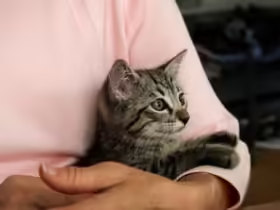Introduction
The image of a cat happily drinking a bowl of milk is a common and nostalgic one. However, many pet owners may not realize that milk is not as harmless for cats as it seems. In fact, most cats are lactose intolerant, which means that milk can cause more harm than good. This blog will explore why cats are lactose intolerant, the effects of milk on feline health, and how to address dietary concerns to manage allergies and reduce cat dander.
Understanding Lactose Intolerance in Cats
1. What is Lactose Intolerance?
- Definition: Lactose intolerance occurs when an animal lacks sufficient levels of lactase, the enzyme needed to break down lactose, the sugar found in milk. Without lactase, lactose cannot be properly digested and absorbed.
- Lactase Production: In kittens, lactase is produced in sufficient amounts to digest their mother’s milk. However, as cats grow and transition to solid food, their lactase production decreases. This reduction often leads to lactose intolerance in adult cats.
2. Why Cats Are Lactose Intolerant
- Evolutionary Adaptation: Cats are obligate carnivores, meaning their diet is primarily composed of meat. Unlike humans and some other animals that can digest lactose, cats’ evolutionary diet did not include dairy products, leading to a reduced need for lactase production.
- Genetic Factors: The ability to digest lactose decreases with age in most mammals, including cats. As they mature, their digestive system becomes less equipped to handle lactose.
Effects of Milk on Feline Health
1. Gastrointestinal Distress
- Common Symptoms: When lactose-intolerant cats consume milk, they often experience gastrointestinal issues such as diarrhea, vomiting, and abdominal pain. These symptoms occur because undigested lactose ferments in the gut, leading to an upset stomach.
- Long-Term Effects: Chronic consumption of milk can lead to persistent gastrointestinal problems, affecting a cat’s overall health and quality of life. This can also exacerbate other health conditions, including those related to skin and coat health.
2. Dehydration and Nutritional Imbalances
- Dehydration Risk: Diarrhea caused by lactose intolerance can lead to dehydration, which is particularly dangerous for cats as it can quickly lead to more severe health issues.
- Nutritional Imbalances: If milk is frequently given as a treat or substitute for a balanced diet, it can lead to nutritional imbalances. Cats need a diet rich in proteins, fats, and essential vitamins, and milk does not meet these needs.
Alternative Treats for Cats
1. Lactose-Free Milk
- Available Options: Lactose-free milk products are specifically formulated to be easier on a cat’s digestive system. These products contain lactase enzyme or have reduced lactose levels.
- Safety Considerations: While lactose-free milk is safer for cats, it should still be given in moderation and not used as a substitute for their primary diet. Always consult your veterinarian before introducing any new treats.
2. Cat-Specific Treats
- Commercial Cat Treats: There are numerous commercial cat treats available that are formulated to meet a cat’s dietary needs without causing gastrointestinal upset. These treats are designed to be both safe and nutritious.
- Homemade Treats: Consider making homemade treats that are specifically tailored for your cat’s dietary needs. Use ingredients that are safe and beneficial for cats, avoiding any dairy products.
Managing Cat Dander and Allergies Through Diet
1. Impact of Diet on Dander Production
- Nutritional Balance: A balanced diet rich in omega fatty acids, vitamins, and minerals can help maintain healthy skin and reduce dander production. Cats with a well-nourished coat tend to produce less dander, which can help minimize allergy symptoms in sensitive individuals.
- Avoiding Allergens: If your cat has allergies or sensitivities, avoid foods that could trigger allergic reactions. This includes certain proteins, grains, and other common allergens. Opt for hypoallergenic or limited-ingredient diets as needed.
2. Hydration and Skin Health
- Water Intake: Ensuring your cat has constant access to fresh water is essential for maintaining hydration and overall skin health. Proper hydration supports healthy skin and can help reduce dander.
- Moisture-Rich Foods: Incorporating wet food into your cat’s diet can help with hydration and provide additional nutrients that support skin health and reduce dander.
Tips for Maintaining a Healthy Diet
1. Establish a Routine
- Consistent Feeding Schedule: Maintain a consistent feeding schedule with high-quality cat food. This helps ensure that your cat receives all the necessary nutrients and prevents dietary imbalances.
- Monitoring Food Intake: Keep track of your cat’s food intake and any changes in their health or behavior. This can help you identify any potential issues early on and adjust their diet as needed.
2. Consult with a Veterinarian
- Veterinary Advice: Regular veterinary check-ups are essential for monitoring your cat’s health and dietary needs. Your vet can provide guidance on the best diet for your cat’s specific health conditions and help you address any issues related to lactose intolerance.
- Dietary Adjustments: If your cat has specific dietary needs or allergies, consult with your vet to develop a tailored diet plan. This ensures that your cat receives appropriate nutrition while managing any allergies or sensitivities.
Conclusion
Cats are naturally lactose intolerant, and milk is not an appropriate or beneficial treat for them. Understanding the effects of milk on feline health and providing suitable alternatives can help prevent gastrointestinal distress and maintain overall well-being. By focusing on a balanced, nutritious diet and avoiding common allergens, you can also manage cat dander and allergies more effectively. Always consult with your veterinarian for personalized advice and ensure that your cat’s dietary needs are met to promote their health and comfort.











Leave a Reply